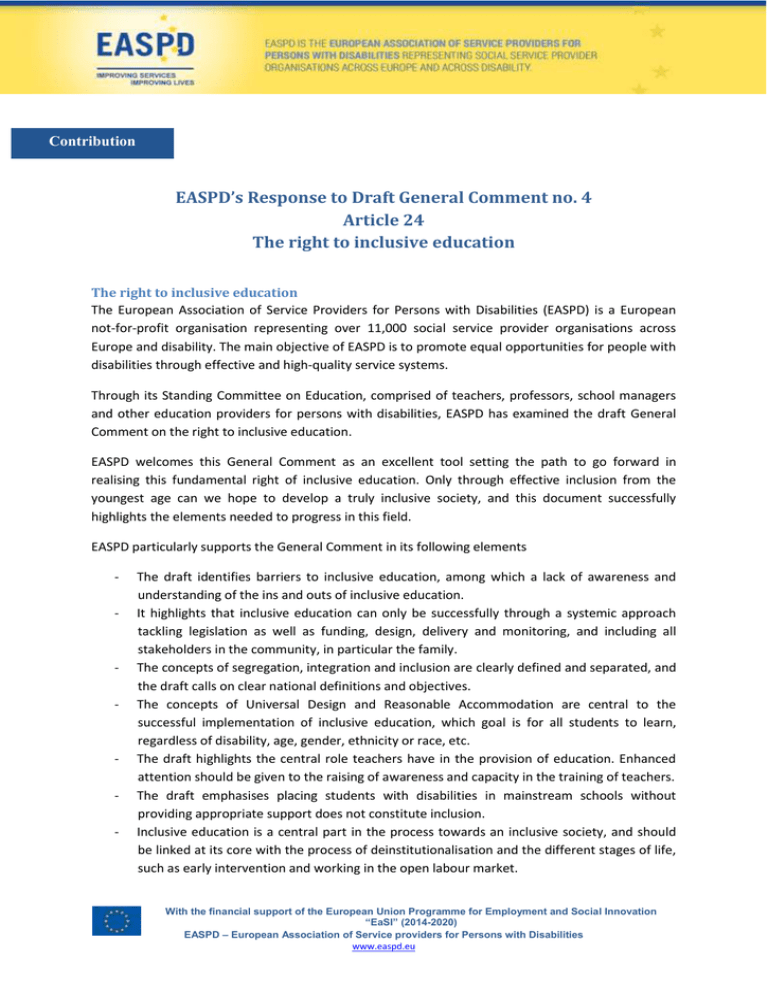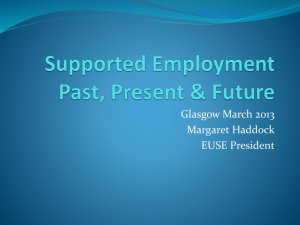EASPD’s Response to Draft General Comment no. 4 Article 24
advertisement

Contribution EASPD’s Response to Draft General Comment no. 4 Article 24 The right to inclusive education The right to inclusive education The European Association of Service Providers for Persons with Disabilities (EASPD) is a European not-for-profit organisation representing over 11,000 social service provider organisations across Europe and disability. The main objective of EASPD is to promote equal opportunities for people with disabilities through effective and high-quality service systems. Through its Standing Committee on Education, comprised of teachers, professors, school managers and other education providers for persons with disabilities, EASPD has examined the draft General Comment on the right to inclusive education. EASPD welcomes this General Comment as an excellent tool setting the path to go forward in realising this fundamental right of inclusive education. Only through effective inclusion from the youngest age can we hope to develop a truly inclusive society, and this document successfully highlights the elements needed to progress in this field. EASPD particularly supports the General Comment in its following elements - - - The draft identifies barriers to inclusive education, among which a lack of awareness and understanding of the ins and outs of inclusive education. It highlights that inclusive education can only be successfully through a systemic approach tackling legislation as well as funding, design, delivery and monitoring, and including all stakeholders in the community, in particular the family. The concepts of segregation, integration and inclusion are clearly defined and separated, and the draft calls on clear national definitions and objectives. The concepts of Universal Design and Reasonable Accommodation are central to the successful implementation of inclusive education, which goal is for all students to learn, regardless of disability, age, gender, ethnicity or race, etc. The draft highlights the central role teachers have in the provision of education. Enhanced attention should be given to the raising of awareness and capacity in the training of teachers. The draft emphasises placing students with disabilities in mainstream schools without providing appropriate support does not constitute inclusion. Inclusive education is a central part in the process towards an inclusive society, and should be linked at its core with the process of deinstitutionalisation and the different stages of life, such as early intervention and working in the open labour market. With the financial support of the European Union Programme for Employment and Social Innovation “EaSI” (2014-2020) EASPD – European Association of Service providers for Persons with Disabilities www.easpd.eu - - - For an effective and consistent approach, the responsibility of inclusive education should be centralised in the hands of the education ministry, while collaborating with other ministries such as social welfare or health. The collection of data and evidence are fundamental in identifying and tackling the barriers to inclusive education. The draft provides a comprehensive description of the process necessary to the transition from segregated to inclusive systems, while offering several models to transfer the resources and expertise from one to the other. The traditional systems of assessment should be reviewed to allow each learner to demonstrate his mastery of the topic to the best of his ability. Strengthening the message EASPD considers the message of the General Comment would be strengthened by considering the following elements. a) Paragraph 5 The biggest barrier to inclusive education is a lack of understanding by the different stakeholders and a fear of the unknown. EASPD suggests to add as a barrier “Lack of understanding of what inclusive education is, of the benefits of inclusive education for the society at large, and of the needs and wishes of people with disabilities.” b) Paragraph 7 If inclusive education is done only for those with the lightest special educational needs, children with more severe disabilities could be left stranded at home without any access to education. EASPD suggests to add “The Committee stresses that particular attention should be given by State Parties to children with severe disabilities or complex needs to ensure that all learners are offered an appropriate education.” c) Paragraph 39 Even though the spirit of the text is not going in that direction, it is feared that the sentence “Deliberately retrogressive measures would require the most careful consideration” is too vague and gives governments too much room to justify their lack of inclusive education implementation. EASPD suggests to either delete this sentence altogether or to require a monitoring system to be implemented alongside retrogressive measures. d) Paragraph 57 With the financial support of the European Union Programme for Employment and Social Innovation “EaSI” (2014-2020) EASPD – European Association of Service providers for Persons with Disabilities www.easpd.eu Oftentimes, the education provided in the classroom represents only a portion of the education of a child and of his inclusion in the school community. Extra-curricular activities are central to the inclusion of children with their peers and should not be foreseen. EASPD suggests to include in this paragraph “The Committeee recognises the importance of activities surrounding the classroom such as the break times and the extra-curricular activities, and State Parties should ensure the full inclusion of children with disabilities in all aspect of the school life.” e) Paragraph 61 While it is agreed that the responsibility for inclusive education should rest with the Education Ministry, this should not be used by State Parties to limit the scope of inclusive education. EASPD suggests to add “This includes all levels of education, formal and informal: early childhood, primary, secondary and tertiary education. All children should have the status of pupils/students, and not only that of service users.” f) Paragraph 64 For inclusive education to be successful, it cannot be limited to a single line of action, but has to be tackled in a systemic way, involving authorities at all levels and all stakeholders across a region. EASPD would suggest to add a paragraph 64 bis “In their different cities and regions, State Parties must foster the collective impact of joint actions between all stakeholders – the different levels of authorities as well as the schools, people with disabilities families and other relevant actors – to set a common vision of inclusive education, specific goals, evidence based actions, and mutual reinforcement actions in schools and education providers. g) Paragraph 67 Including children from the youngest age is the best way to ensure their inclusion in the education system. EASPD suggests to add “Early childhood intervention services should be equally inclusive”. For additional information, please contact Timothy Ghilain Policy Officer T. +32 2 282 46 12 timothy.ghilain@easpd.eu www.easpd.eu Luk Zelderloo Secretary General T. +32 2 282 46 10 luk.zelderloo@easpd.eu www.easpd.eu With the financial support of the European Union Programme for Employment and Social Innovation “EaSI” (2014-2020) EASPD – European Association of Service providers for Persons with Disabilities www.easpd.eu







